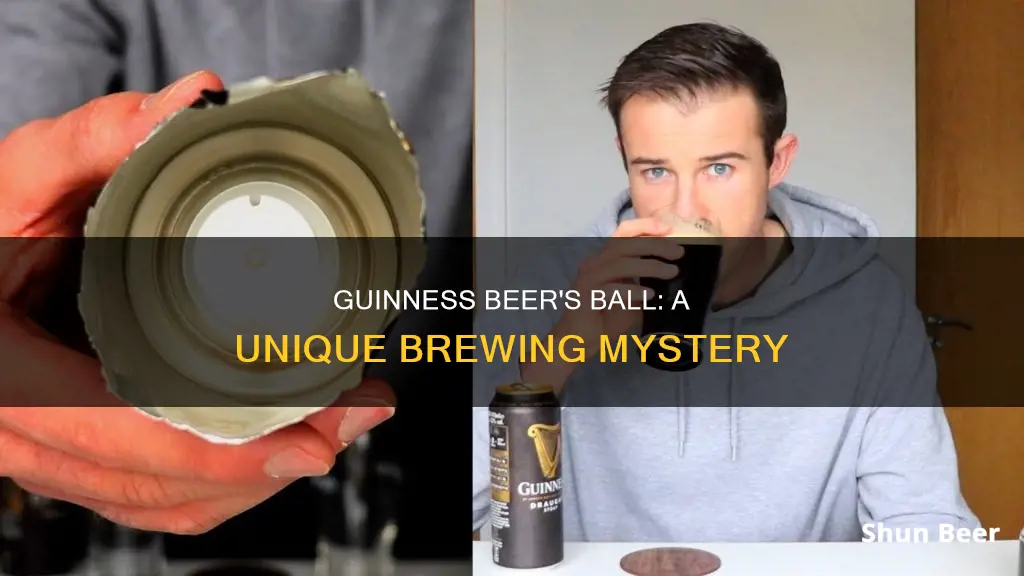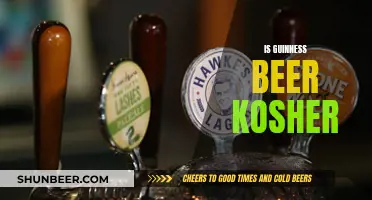
Guinness beer cans contain a plastic ball, commonly known as a widget, which replicates the draught experience by releasing nitrogen into the beer to give it a smooth, creamy head. This widget was developed by Guinness in 1969 and first released in 1989, with a new version launched in 1997 to address issues with the original design. The widget is a hollow, spherical piece of food-grade plastic with a small hole, and it works by allowing pressurised nitrogen to trickle into it during the canning process. When the can is opened, the widget releases the nitrogenated beer, creating a surge of bubbles and a thick, creamy head.
| Characteristics | Values |
|---|---|
| Name | Widget, Smoothifier |
| Composition | Hollow, spherical piece of food-grade plastic with a tiny hole in it |
| Size | Similar to a ping pong ball |
| Colour | White |
| Function | Releases nitrogen into the beer to give it a creamy, velvety texture and a foamy head |
| Inventor | Guinness |
| Inventor Names | Tony Carey, Sammy Hildebrand |
| Year of Invention | 1969 |
| Year of Launch | 1997 |
What You'll Learn
- The widget: A small plastic ball inside Guinness cans
- The smoothifier: A floating widget that doesn't overflow when served warm
- Nitrogenation: The process of adding nitrogen to beer
- The history of the widget: From its patent in 1969 to its release in 1989
- Other beers using widgets: Beers like Old Speckled Hen and Young's Double Chocolate Stout also use widgets

The widget: A small plastic ball inside Guinness cans
The widget is a small plastic ball, about the size of a golf ball, inside Guinness cans. It was developed by Guinness in 1969 to give their canned beers a silky, creamy head. During the canning process, brewers add liquid nitrogen to the beer, which quickly evaporates, creating pressure inside the can. This forces gas and liquid into the widget through its tiny hole. When the can is opened, the pressure drops, causing the nitrogenated beer inside the widget to be released into the rest of the beer, creating a foamy head and a smooth, velvety texture.
The widget was designed to replicate the draught beer experience in a can. Guinness was the world's first nitro beer, and nitrogen bubbles are smaller than carbon dioxide bubbles, resulting in a smoother and more delicate head and taste. The widget helps to maintain the desired levels of nitrogen in the beer once the can is opened, slowly releasing nitrogen into the beer.
The first-generation widget was released in 1989 and was a flattened disc that sat at the bottom of the can. However, if the beer was warm, it could overflow after the can was opened. In 1997, Guinness introduced the floating, spherical widget that is used in cans today, called the "Smoothifier." This widget floats inside the can and does not cause overflow issues.
The widget has been a popular innovation, with other beers adopting similar technology. In a 2004 survey, almost 9,000 people voted for the widget as a greater invention than the internet. The widget has maintained its magic, delivering a perfectly smooth and creamy Guinness beer every time.
Guinness Beer: Kosher Certification and Jewish Drinking Traditions
You may want to see also

The smoothifier: A floating widget that doesn't overflow when served warm
The widget is a small plastic ball that sits inside a can of Guinness beer. It was developed to give their canned beers a silky, creamy head, replicating the draught experience. The widget was first patented in 1969, but Guinness didn't release their first-generation widget until 1989. This widget was a flattened disc that sat at the bottom of the can. While it worked well when the beer was served cold, it caused the beer to overflow when served warm.
To fix this problem, in 1997, Guinness released a new version of the widget, a floating spherical widget called the "Smoothifier". This widget is a hollow, spherical piece of food-grade plastic with a tiny hole in it and is similar in appearance to a ping pong ball. During the canning process, brewers add liquid nitrogen to the beer, which quickly evaporates and creates pressure inside the can. This pressure forces gas and liquid into the widget through its tiny hole. When the can is opened, the gas and liquid leave the widget and mix with the beer, creating a foamy head and a smooth, velvety texture.
The Smoothifier was designed to fix the issue of overflow when the beer is served warm. The floating design of the widget allows it to move freely inside the can, ensuring that the beer flows around it and out of the can without causing overflow. This innovative design not only improved the drinking experience but also enhanced the reputation of Guinness as a brand dedicated to innovation.
The widget has become a beloved part of the Guinness drinking experience, with many customers enjoying the unique ritual of hearing the "pssshhh" sound when the can is opened and watching the beer transform into a perfectly smooth and creamy pint. The Smoothifier has played a crucial role in delivering the iconic taste and texture of Guinness to beer enthusiasts around the world.
In conclusion, the Smoothifier is a floating widget designed by Guinness to address the issue of overflow in warm beer. Its innovative structure and functionality ensure a smooth and enjoyable drinking experience, solidifying Guinness's position as a pioneer in the beer industry.
Guinness Beer: Does It Expire?
You may want to see also

Nitrogenation: The process of adding nitrogen to beer
Nitrogenation is the process of adding nitrogen to beer. Nitrogen is typically added to beer to give it a sweeter, silkier taste and texture. Nitrogen bubbles are smaller than carbon dioxide bubbles, resulting in a smoother and more delicate head and taste. This process also creates a thicker, more velvety "mouthfeel" without the acidic bite of carbonation with CO2.
The addition of nitrogen to beer was first pioneered by Guinness, who developed a system for producing draught-type beer from cans or bottles through the discharge of gas from an internal compartment. This system, known as the "widget", was patented in 1969 and released to the market in 1989. The widget is a small, hollow, spherical piece of food-grade plastic with a tiny hole in it, similar in appearance to a ping pong ball.
During the canning process, brewers add liquid nitrogen to the beer immediately before sealing it. The liquid nitrogen quickly evaporates, creating pressure inside the can. This pressure forces gas and liquid into the widget through its tiny hole. When the can is opened, the pressure drops, causing the nitrogenated beer inside the widget to jet out and mix with the rest of the beer. This creates a foamy head and a surge of bubbles, replicating the draught beer experience.
The widget has been a popular innovation, with several other beer brands adopting it since its introduction by Guinness. It has also been voted as one of the greatest inventions of the 20th century by consumers, highlighting its impact and recognition in the beer industry.

The history of the widget: From its patent in 1969 to its release in 1989
In 1969, Guinness brewers Tony Carey and Sammy Hildebrand at the company's St James's Gate Brewery in Dublin developed a system for producing draught-type Guinness from cans or bottles through the discharge of gas from an internal compartment. The company filed a patent application in Ireland for an "Improved Method of and Means of Dispensing Carbonated Liquids from Containers". This was the birth of the widget, a small plastic ball with a hole in it that sits inside a can of beer.
The development of the widget was put on hold as technical difficulties arose. Guinness instead concentrated on bottles using external initiators. It wasn't until 1984 that work on the widget was restarted under the direction of Alan Forage. The design of an internal compartment that could be readily inserted during the canning process was then devised by Alan Forage and William Byrne. Work started on the widget during the period 1984-85. The plan was to introduce a plastic capsule into the can, pressurise it during the filling process, and then allow it to release this pressure in a controlled manner when the can was opened. This would be sufficient to initiate the product and give it the characteristic creamy head.
The first samples sent to Dublin were labelled "Project Dynamite", which caused some delay before customs and excise would release the samples. Because of this, the name was changed to Oaktree in recognition of the earlier Acorn project. The development of ideas continued and more than one hundred alternatives were considered. The blow-moulded widget was to be pierced with a laser, but this was abandoned in favour of gas-exchanging air for nitrogen on the filler, and producing the inserts with a hole in place using straightforward and cheaper injection-moulding techniques.
Commissioning began in January 1988, with a national launch date of March 1989. This first-generation widget was a plastic disc held in place by friction at the bottom of the can. This method worked fine if the beer was served cold, but when served warm, the can would overflow when opened. In 1997, Guinness released the floating, spherical widget found in cans today, which they call the "smoothifier".

Other beers using widgets: Beers like Old Speckled Hen and Young's Double Chocolate Stout also use widgets
The "widget" in Guinness beer is a small plastic ball that releases gas when the can is opened, replicating the draught experience in a can. During the canning process, brewers add liquid nitrogen to the beer, which quickly evaporates and creates pressure inside the can. This forces gas and liquid into the widget through its tiny hole. When the can is opened, the gas and liquid leave the widget and mix with the beer, creating a foamy head.
Guinness first patented the widget idea in 1969 but released its first-generation widget in 1989. This widget was a flattened disc that sat at the bottom of the can. While it worked well with cold beer, it caused the beer to overflow when served warm. To fix this problem, Guinness released a new version of the widget, the "smoothifier", in 1997. This floating, spherical widget can be found in cans of Guinness today.
The popularity of widgets has caught on since Guinness introduced them, and other beers have followed suit. Beers like Old Speckled Hen and Young's Double Chocolate Stout also use widgets. Old Speckled Hen is a bitter with a 5.2% ABV that was first brewed in Abington, Oxfordshire, in 1979. Young's Double Chocolate Stout, on the other hand, is a milk stout with 5% alcohol. It has a sweet taste coming from the chocolate malt. These beers, along with others like Murphy's Stout and Boddington's Pub Ale, have adopted the use of widgets to enhance the drinking experience and create a thick, creamy head similar to that of a draught beer.
Frequently asked questions
Guinness beer contains a ball, known as a widget, to give the beer a smooth, velvety texture and a creamy head.
During the canning process, brewers add liquid nitrogen to the beer, which quickly evaporates and creates pressure inside the can. When the can is opened, the pressure drops and the nitrogenated beer inside the widget is released into the rest of the beer, creating a foamy head.
The widget is a hollow, spherical piece of food-grade plastic with a small hole in it. It is similar in appearance to a ping pong ball and is approximately 3 centimetres in diameter.







